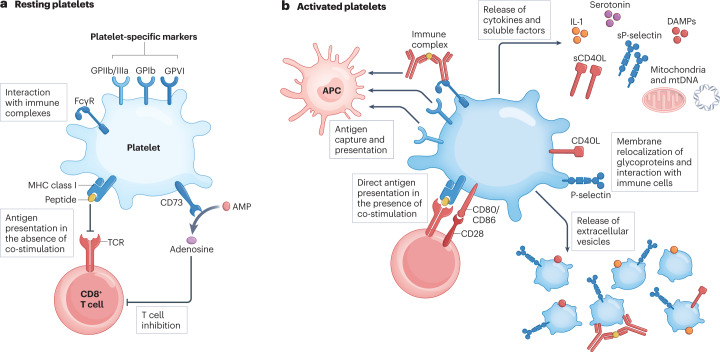Fig. 1. Effects of platelet activation.
a, Resting platelets express platelet-specific markers such as the glycoproteins GPIIb/IIIa, GPIb and GPVI. Platelets also express Fcγ receptor (FcγR), which enables them to scavenge circulating immune complexes. Resting platelets may inhibit CD8+ T cells by the expression of MHC class I molecules in the absence of co-stimulatory molecules, as well as by expressing the ectonucleosidase CD73, which catalyses the production of anti-inflammatory adenosine from adenosine monophosphate (AMP). b, Activated platelets release cytokines such as IL-1, and molecules such as soluble P-selectin (sP-selectin), soluble CD40 ligand (sCD40L) and serotonin. They also release damage-associated molecular patterns (DAMPs), such as calprotectin and high mobility group box 1 (HMGB1), and extrude mitochondria and mitochondrial DNA (mtDNA) into the extracellular milieu. Activated platelets relocalize to their surface glycoproteins such as P-selectin and CD40L that are initially present in cytoplasmic granules, which promotes interaction with immune cells. Platelet antigens and scavenged immune complexes are captured by antigen-presenting cells (APCs) for processing and immune presentation. Furthermore, platelets express MHC class I molecules together with the co-stimulatory molecule CD86, and may directly present antigen to CD8+ T cells and promote their activation. Finally, activated platelets produce platelet-derived extracellular vesicles that contain platelet-derived molecules such as P-selectin, CD40L, HMGB1 and IL-1. TCR, T cell receptor.

